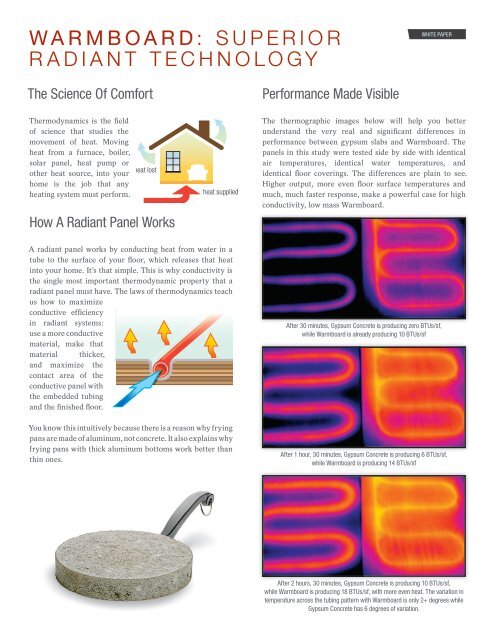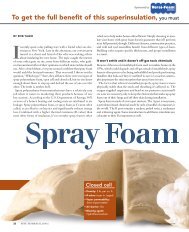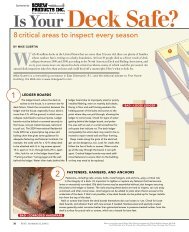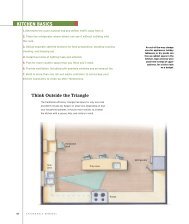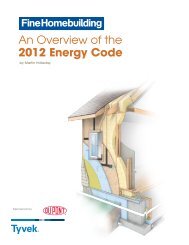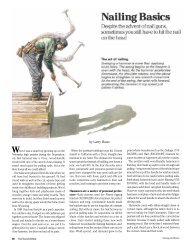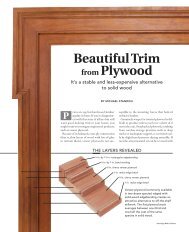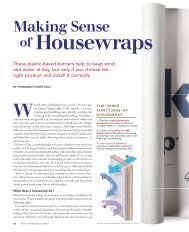warmboard: superior radiant technology - Fine Homebuilding
warmboard: superior radiant technology - Fine Homebuilding
warmboard: superior radiant technology - Fine Homebuilding
You also want an ePaper? Increase the reach of your titles
YUMPU automatically turns print PDFs into web optimized ePapers that Google loves.
WARMBOARD: SUPERIOR<br />
RADIANT TECHNOLOGY<br />
The Science Of Comfort<br />
Thermodynamics is the field<br />
of science that studies the<br />
movement of heat. Moving<br />
heat from a furnace, boiler,<br />
solar panel, heat pump or<br />
other heat source, into your<br />
home is the job that any<br />
heating system must perform.<br />
How A Radiant Panel Works<br />
A <strong>radiant</strong> panel works by conducting heat from water in a<br />
tube to the surface of your floor, which releases that heat<br />
into your home. It’s that simple. This is why conductivity is<br />
the single most important thermodynamic property that a<br />
<strong>radiant</strong> panel must have. The laws of thermodynamics teach<br />
us how to maximize<br />
conductive efficiency<br />
in <strong>radiant</strong> systems:<br />
use a more conductive<br />
material, make that<br />
material thicker,<br />
and maximize the<br />
contact area of the<br />
conductive panel with<br />
the embedded tubing<br />
and the finished floor.<br />
You know this intuitively because there is a reason why frying<br />
pans are made of aluminum, not concrete. It also explains why<br />
frying pans with thick aluminum bottoms work better than<br />
thin ones.<br />
Performance Made Visible<br />
WHITE PAPER<br />
The thermographic images below will help you better<br />
understand the very real and significant differences in<br />
performance between gypsum slabs and Warmboard. The<br />
panels in this study were tested side by side with identical<br />
air temperatures, identical water temperatures, and<br />
identical floor coverings. The differences are plain to see.<br />
Higher output, more even floor surface temperatures and<br />
much, much faster response, make a powerful case for high<br />
conductivity, low mass Warmboard.<br />
After 30 minutes, Gypsum Concrete is producing zero BTUs/sf,<br />
while Warmboard is already producing 10 BTUs/sf<br />
After 1 hour, 30 minutes, Gypsum Concrete is producing 6 BTUs/sf,<br />
while Warmboard is producing 14 BTUs/sf<br />
After 2 hours, 30 minutes, Gypsum Concrete is producing 10 BTUs/sf,<br />
while Warmboard is producing 18 BTUs/sf, with more even heat. The variation in<br />
temperature across the tubing pattern with Warmboard is only 2+ degrees while<br />
Gypsum Concrete has 6 degrees of variation.
Engineered for Better Performance<br />
Warmboard was engineered to take maximum advantage of<br />
the laws of thermodynamics. The panel uses an alloy that is<br />
30% more conductive than conventional aluminum alloys.<br />
The thick aluminum plate is in direct contact with your<br />
finish floor material. The aluminum is also stamped in highly<br />
sophisticated dies so that it covers every square inch of your<br />
floor and makes excellent contact with the large diameter ½"<br />
tubing. The result:<br />
• Higher output at lower water temperatures for<br />
energy savings<br />
• More even floor temperatures for greater comfort<br />
• Moreevenfloortemperaturesforbetterperformancewith<br />
fine hardwood floors<br />
A Word About Thermal Mass<br />
In the past, <strong>radiant</strong> heat had a good reputation for comfort<br />
once the floor reached the correct temperature. But the<br />
high mass gypsum concrete slab based systems which were<br />
common when <strong>radiant</strong> was first popularized in the 1950’s,<br />
took many hours or even days to get to the right temperature.<br />
Given a blank sheet of paper, no engineer familiar with the<br />
laws of thermodynamics would choose such a material for a<br />
<strong>radiant</strong> panel. Gypsum concrete is a poor conductor and its<br />
high mass makes it difficult to accurately meet the changing<br />
heating needs of your home on any hourly or daily basis.<br />
Slab based <strong>radiant</strong> is less than ideal for other reasons:<br />
• They require additional construction costs to support<br />
their weight<br />
• They make it difficult to install hardwood and many other<br />
finish floor materials<br />
• Unyielding, rigidly hard slabs are uncomfortable to stand<br />
or walk on<br />
• They bring moisture into your home, increasing the risk<br />
of mold<br />
Warmboard Inc.<br />
8035 Soquel Drive, Suite 41-A<br />
Aptos, California 95003-3948<br />
877.338.5493<br />
<strong>warmboard</strong>.com<br />
020112<br />
The Right Amount of Heat, Right When<br />
You Want It<br />
All homes have their heat loads change throughout the day as the<br />
sun rises or sets, weather changes, lights or ovens are turned on,<br />
guests arrive or leave. Warmboard will quickly adjust your floor<br />
temperatures to meet those changes. High mass simply can’t<br />
keep up.<br />
70º<br />
50º<br />
30º<br />
Concrete chases temperature<br />
Warmboard maintains<br />
even temperature<br />
Outside<br />
temperatures<br />
6am 12pm 6pm 12am 6am 12pm<br />
When you return to a home that had its temperature lowered<br />
for vacation set back, low mass Warmboard will make you<br />
comfortable in a couple of hours instead of a day later.<br />
70º<br />
60º<br />
50º<br />
Warmboard gets to temperature<br />
far more quickly<br />
Concrete heats up slowly<br />
2 4 6 8 10<br />
Bottom line, Warmboard is the best choice for <strong>radiant</strong> because<br />
unlike the systems used in the infancy of the <strong>radiant</strong> industry,<br />
it was engineered to take maximum advantage of the laws of<br />
thermodynamics. Good science ensures your comfort.


